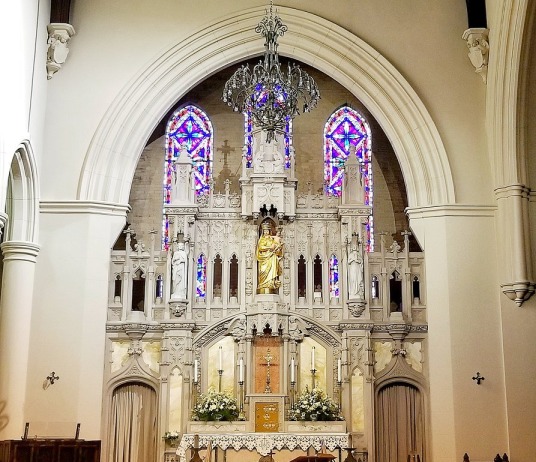
The following account was published by William J. Walsh in Volume III of The Apparitions and Shrines of
Heaven's Bright Queen
– a four-volume collection said to be compiled from approved Catholic Publications.
Unfortunately the author and source of this article were not named. We may infer that the author was a resident of
New Orleans and that he wrote the following in the year 1891 – a fact which becomes obvious in the second paragraph.
The last paragraph of the article appears to have been added at a later date, as it mentions the crowning ceremony of 1895.

The weather is gloomy; the wind is blowing; the Mississippi, in front of my lowly dwelling, has thrown off his usually placid appearance to assume the airs of an angry ocean; while I, seated by the fire, am musing. However, I take up my pen, remembering that this is the anniversary of a glorious miracle.
In the afternoon the various military associations will parade the streets; they will repair to the inauguration
of the Historical Museum, in which are to be preserved memorials of Louisianian exploits, with trophies of the principal battles
won; but the cause of Louisiana's most signal victory will probably never have its memento there – it is unremembered.
On this the seventy-sixth anniversary of the battle of New Orleans, the patriotism and valor of Louisian's sons will
deservedly be extolled; the national flag will be unfurled in token of their country's gratitude; but where will be the
banner which should, on this joyful occasion, wave above every other? In this morning's Picayune (the local newspaper)
appears an article relative to the battle of Chalmette, from which I quote the following just appreciation: The result
seems almost miraculous. It was a remarkable victory, and it can never fail to hold an illustrious place in our national
history.
Now all this is quite true; for (General – later President – Andrew) Jackson, with only six thousand men, had to fight against the flower of the British troops, fifteen thousand strong; so that if the three thousand slain on the side of the English declared their defeat a miracle, the six killed and seven wounded on the American side proclaimed far more eloquently the victory of Jackson to be miraculous. But nowadays people seem to have forgotten that marvel.
For many a long year priests were wont on this day to remind their congregations of the miracle wrought by the
right hand of the Almighty on the plain of Chalmette, whereon were once more verified these words of the divine oracle;
The horse is prepared for the day of battle, but the Lord giveth safety.
Jackson and his valiant few seemed to have
been convinced of this truth; and if they remained unalarmed by the overwhelming number of their enemies, it was probably
because they bore in mind the words of the royal psalmist: Some trust in chariots and some in horses, but we will call
upon the name of the Lord our God.
While the men were fighting bravely on the plain of Chalmette, many a devoted mother, wife and sister were
praying in the Ursuline Chapel; and soon could the victorious army exclaim: They are bound and have fallen;
but we are risen and are set upright.
For a long time these heroes and their descendants, though not failing to
render to Caesar the things that are Caesar's,
did not forget on this glorious anniversary, to render to God the
things that are God's;
saying to Him, in the words of Holy Scripture: Not unto us, O Lord! not unto us, but unto Thy
Name be glory given.
But who is yet mindful?
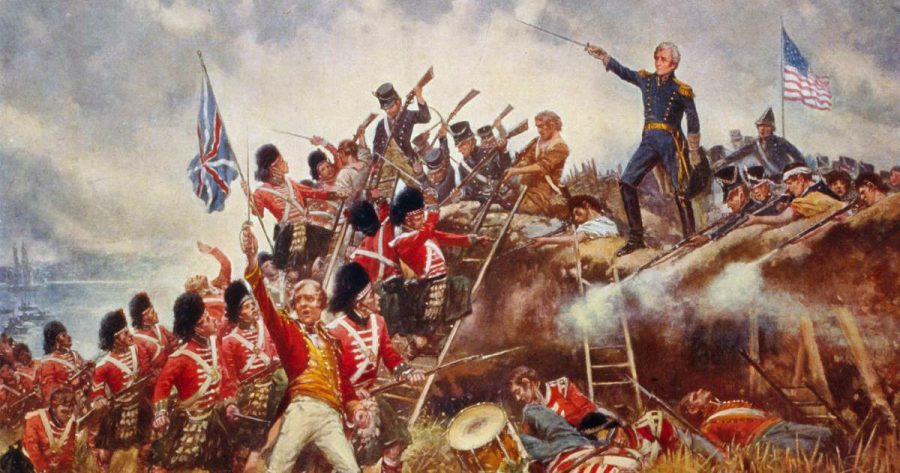
For a long time the religious festival in commemoration of this glorious victory surpassed in splendor
the military festival. An old journal, giving an account of January 8, 1841, says: Archbishop Blanc, accompanied by
the Bishops of Mobile and Natchez, and all the clergy, presided at the ceremony, during which the Governor and members
of the Legislature occupied the seats of honor in the cathedral.
Today, while surveying the streets adorned with flags,
while admiring the splendor of the military costumes, and hearing the flourish of trumpets and the thundering of cannon,
people will say to themselves: It is the anniversary of the Battle of New Orleans.
How many will add: It is
the anniversary of the day on which, through the intercession of Our Lady of Prompt Succor, the wondrous victory was gained,
the city saved from pillage and ruin?
The foundation of the Ursuline Convent, New Orleans, is essentially French, having been founded in 1727, by French religious, under the auspices of Louis XV. In 1763 Louisiana became a Spanish possession; hence it was only natural for the community to recruit subjects from that nationality. The retrocession of Louisiana to France in 1800 created great excitement at the Convent, whose inmates feared a repetition of the horrors of the French Revolution. The majority of the Sisters being then Spanish, the superioress, Mother St. Monica Ramos, a native of Havana, addressed in 1802 a petition to Charles IV, King of Spain, begging his Catholic Majesty to allow herself and the community to retire to her native city. Without waiting for the royal answer, she, with fifteen religious, left the Convent of New Orleans on the evening of May 20, 1803.
Not a gleam of hope seemed left to the seven Sisters who remained. However, they courageously set to work; and their zeal succeeded in keeping up the boarding-house, day-school, and orphan asylum, as well as the instruction of black women and girls in Christian doctrine. In this conjuncture, Mother St. André Madier felt inspired to address herself to a cousin of hers, whom the Reign of Terror had driven from her convent, and with whom we must now become acquainted.
Agatha Gensoul, in religion Madame St. Michel, besides being remarkably pious, was endowed with talents of a high order, and possessed of amiable and distinguished manners. Though expelled by the Revolution from her Convent of Pont St. Esprit, separated from her Sisters in religion, and compelled to conceal even her title of religion, she continued to preserve the spirit of her holy vocation. On the first indication of religious toleration, she quitted her solitude, and did her utmost to clear away the débris with which the impiety of the Revolution had encumbered the vineyard of the Lord. Where now are her former co-laborers? In vain does she seek them. Privations, exile, the scaffold have cut off nearly all. She understands the futility of her efforts to re-establish her community; but she remembers that a true Ursuline ought never to lose courage. True, no convent of her Order then existed in France; but she was still an Ursuline, obliged by her vocation to instruct young girls, to train their hearts to virtue, and to store their minds with useful knowledge. This explains why Madame St. Michel, aided by another Ursuline, known in the world as Miss Sophie Ricard, opened a boarding-school at Montpellier. It was then that she received the letter of Mother St. André, telling how much the New Orleans convent stood in need of subjects. Immediately she felt inspired to abandon her own foundation, and hasten to the relief of her Sisters in Louisiana. Here let us note the obstacles in the way of her carrying out this generous resolution. The more numerous and powerful they are, the better will they serve to establish the miraculous result of the intercession of Our Lady of Prompt Succor.
France was just recovering from the baneful effects of the Revolution, which had left behind it only ruins.
For many years there were no priests or religious to teach the children, who had grown up in the shadow of deserted convents,
desecrated churches, overturned altars... Madame St. Michel was a person of no ordinary abilities, and already had her zealous
labors been crowned with wonderful success. Therefore her Bishop could not even think of dispensing with her services in his
diocese. Aware of this, her spiritual director, who was first consulted, gave no answer. She then addressed herself to the
Bishop. To form an idea of his surprise and grief, as well as of the force of his opposition, one need but reflect on his
answer: The Holy Father alone can give this authorization.
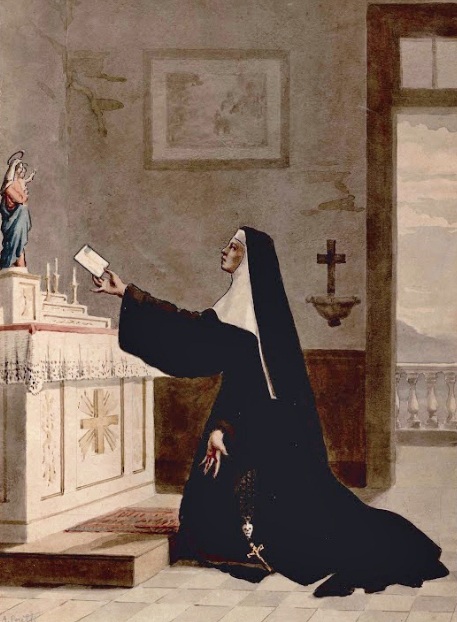 The Pope was still at Rome. There were no railroads or steamboats; the distance was considerable; but the greatest
obstacle of all, and that which seemed humanly insurmountable, was that Pope Pius VII was a real captive at Rome, while awaiting
to be dragged as such to Fontainbleau. Napoleon held close custody; and the jailers of the Holy Father in the Eternal City had
received strict orders to prevent every communication, even by letter, with the Vicar of Jesus Christ. Consequently, writing to
the Pope and expecting an answer from him was, humanly speaking, an act of folly. This, however, Madame Gensoul felt inspired by
God to attempt. Accordingly, on December 15, 1808, she wrote to the Pope. After having set forth her motives, she concluded thus:
The Pope was still at Rome. There were no railroads or steamboats; the distance was considerable; but the greatest
obstacle of all, and that which seemed humanly insurmountable, was that Pope Pius VII was a real captive at Rome, while awaiting
to be dragged as such to Fontainbleau. Napoleon held close custody; and the jailers of the Holy Father in the Eternal City had
received strict orders to prevent every communication, even by letter, with the Vicar of Jesus Christ. Consequently, writing to
the Pope and expecting an answer from him was, humanly speaking, an act of folly. This, however, Madame Gensoul felt inspired by
God to attempt. Accordingly, on December 15, 1808, she wrote to the Pope. After having set forth her motives, she concluded thus:
Most Holy Father, I appeal to Your apostolic tribunal. I am ready to submit to Your decision. Faith teaches me that You are the
voice of the Lord. I await Your orders. 'Go,' or 'Stay,' from Your Holiness will be to me the same thing.
The letter was written, but how could it be made to reach its destination? Three months passed, and still there was
no opportunity of sending it. Madame St. Michel knelt before a statue of Mary, to whom she recommended the success of her enterprise;
and while thus praying she felt inspired to address the Queen of Heaven in these words: O Most Holy Virgin! if Thou dost obtain for
me a prompt and favorable answer, I promise to have Thee honored at New Orleans under the title of Our Lady of Prompt Succor.
Now if this inspiration had come from Heaven, if Mary was pleased with this new appellation, if She desired being honored under this beautiful title at New Orleans, let Her fulfill the two conditions laid down by the suppliant, and doubt would no longer be admissible. The letter left Montpellier on the 19th of March, 1809; and the answer is dated Rome, April 29, 1809. Hence the first condition, that of receiving a prompt reply, was accomplished. Let us here note that, owing to the reasons already stated, the promptitude of the Pope's answer is remarkable. We shall now see how the second condition was fulfilled, bearing in mind that Pope Pius VII knew the state of affairs in France, and the need of laborers like the applicant to regenerate it. Still, he did not hesitate to approve of her coming to Louisiana. No better proof can be given of the accomplishment of the second condition than the following passages from Cardinal Pietro's letter to the pious petitioner:
I am charged by the Holy Father Pope Pius VII with answering in his name... His Holiness cannot do otherwise than approve
the esteem and attachment you have retained within yourself for the religious state, and the spirit you have maintained within yourself of
the Institute of St. Ursula. The Holy Father has experienced the greatest consolation on learning that a convent of an Order so useful,
and which has rendered such signal services to the Church, is established in Louisiana; and that piety, peace, and the most exact regularity
reign therein... His Holiness approves of your putting yourself at the head of your religious aspirants, to serve as their guide during the
long and difficult voyage which you are about to undertake.
Good Mother St. Michel unquestionably obtained a prompt and favorable answer. The Bishop of Montpellier was so surprised that he acknowledged himself vanquished. The devoted Ursuline began to fulfill her promise, by ordering a fine statue of Our Lady of Prompt Succor to be sculpted. Bishop Fournier himself was so convinced of the Blessed Virgin's desire of being honored under this title that he expressed a wish to bless the statue, which was to be the shield of the pious missionaries during their passage across the Atlantic. On their arrival at New Orleans, December 31, 1810, this precious statue was solemnly installed in the Convent chapel. And from that time may be said to date the public devotion offered to the Blessed Virgin under the title of Our Lady of Prompt Succor.
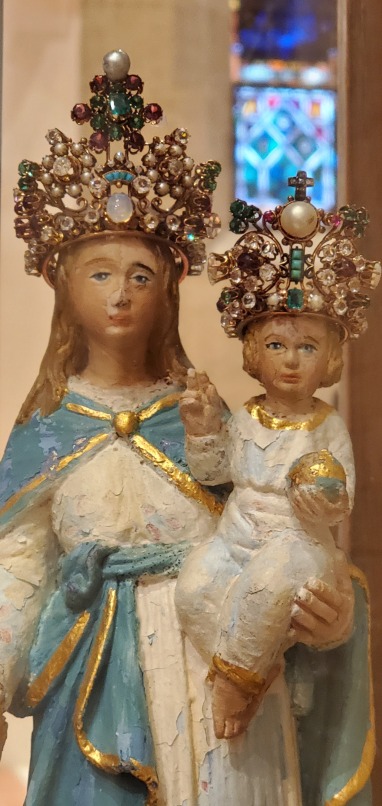 It is a fact worthy of mention that this statue had been preceded by another smaller one, brought in 1780 from the Convent of Pont St. Esprit.
We know not if Mother St. Michel Gensoul had, during her stay in that convent, become acquainted with the history of this statue, of which the
one brought by her seems to have been a reproduction; and which had, under somewhat similar circumstances, been instrumental in showing the
Blessed Virgin's power with Her Divine Son. Let us now see how this came to pass.
It is a fact worthy of mention that this statue had been preceded by another smaller one, brought in 1780 from the Convent of Pont St. Esprit.
We know not if Mother St. Michel Gensoul had, during her stay in that convent, become acquainted with the history of this statue, of which the
one brought by her seems to have been a reproduction; and which had, under somewhat similar circumstances, been instrumental in showing the
Blessed Virgin's power with Her Divine Son. Let us now see how this came to pass.
In 1785 Mother St. James, superioress of the Ursulines in New Orleans, seeing with regret that her community, hitherto eminently French,
would soon cease to be such if not recruited from the mother country, applied for subjects to the flourishing house of her Order at Pont St. Esprit.
Three Sisters – Sr. Marie Thérèse Farjon de St. F. Xavier, Sr. Françoise Alzas de Ste. Félicité, and Sr. Christine Madier de St. André – nobly
responded to her appeal; but many obstacles were opposed to their departure. The Spanish Government of this colony seemed desirous of doing away
with the French character of the Ursuline community; therefore, we need not be surprised at the difficulties which the religious of Pont St. Esprit
had to surmount in carrying out their generous resolution. Weary of waiting for an opportunity of reaching the new field of her labors,
Sr. Ste. Félicité having one day found in the garret of her convent a little statue of the Blessed Virgin, picked it up, saying with that childlike
simplicity so pleasing to the Heart of Mary: Good Mother, if Thou dost quickly remove the obstacles which lie in the way of my departure for New Orleans,
I promise to have Thee honored there to the utmost of my power.
Here the condition laid down is the same as that which, twenty-five years later,
will be laid down by Mother St. Michel – the speedy removal of obstacles. Now for the result.
An aged Father of the Society of Jesus having applied directly to the King of Spain, the obstacles were immediately removed; and the three Ursulines on leaving France brought away with them their little statue, which they regarded as their most precious earthly treasure. Later on, Sr. Ste. Félicité, having been chosen to hold the highest office of the community, found it easy to fulfill her promise to the Blessed Virgin, whose statue, placed over the superior's stall, soon became a special object of devotion. On the Feast of the Assumption it was customary to place this statue on an altar decorated with flowers and lighted tapers; and there did our Heavenly Mother, as a Queen on Her throne, receive the homage of Her devoted subjects; after which the superioress, accompanied by the senior members of the community, advanced to lay at Her feet the keys of the Convent, in token of Her being their Mother and first Superior. Since 1810 the two statues of which we have given the history have been honored under the title of Our Lady of Prompt Succor.
If the devotion which has for over eighty years been paid in New Orleans to Our Lady of Prompt Succor has been pleasing to Her,
She must have within that period manifested Her pleasure in an evident manner. It comes not within our sphere to relate here all the spiritual
and temporal favors attributed to Her intercession. The chronicles of the Convent sum up these favors by saying: Under this new title the
Blessed Virgin has so often manifested Her power and goodness, that the religious repose in Her an unbounded confidence.
Two facts in proof
of this assertion deserve record.
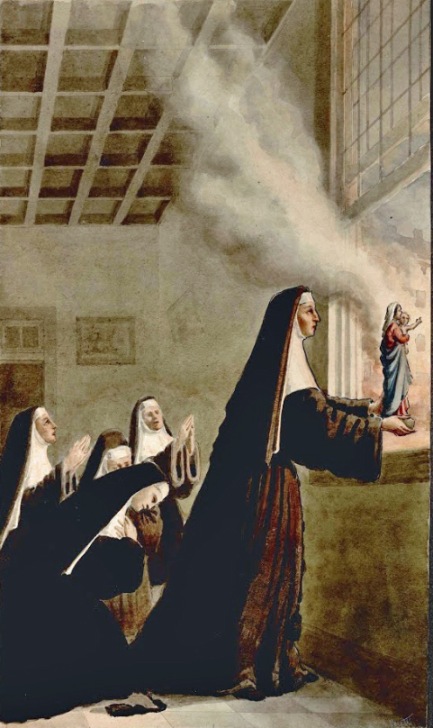 Devotion to Our Lady of Prompt Succor was just commencing to spread through the city when, in 1812, a terrible fire broke out.
The wind was rapidly driving the flames toward the Convent, and the nuns were told that remaining there any longer would be tempting Divine Providence.
The order to break through the cloister was already given, when a lay Sister, Sr. St. Anthony, placed the little statue of Our Lady of Prompt Succor
on a window in front of the fire; and at the same moment Mother St. Michel fell on her knees, exclaiming:
Devotion to Our Lady of Prompt Succor was just commencing to spread through the city when, in 1812, a terrible fire broke out.
The wind was rapidly driving the flames toward the Convent, and the nuns were told that remaining there any longer would be tempting Divine Providence.
The order to break through the cloister was already given, when a lay Sister, Sr. St. Anthony, placed the little statue of Our Lady of Prompt Succor
on a window in front of the fire; and at the same moment Mother St. Michel fell on her knees, exclaiming: Our Lady of Prompt Succor, we are lost
if Thou dost not come to our help!
Immediately the wind changed, the Convent and its environs were out of danger.
We will not repeat here what we have already said relative to the Battle of 1815. From the windows of their convent the Ursulines
could see the smoke rising from the battlefield, and could hear the report of guns and the thunder of cannon. The night of January 7th was spent
in prayer before the Blessed Sacrament. Everything seemed hopeless for the Americans. The disproportion of troops ensured victory to the English,
in which case nothing save the horrors of pillage could be expected for the conquered city – the brutal watchword being Booty and Beauty.
(A creole planter, who had feigned loyalty to the British side, was present at a dinner of the British officers, at which he overheard one of
them proposing the toast, To beauty and booty.
)
Jackson had sworn that, should he be vanquished, the enemy would find New Orleans a heap of ruin. In order to help in averting this imminent danger, the Ursuline chapel was continually thronged with pious ladies, all weeping and praying at the foot of the holy statue, which was placed on the high altar; and there, as a mother in the midst of her weeping children, did Mary listen to the supplications of Her devout clients, and plead their cause with the Heart of Her Divine Son.
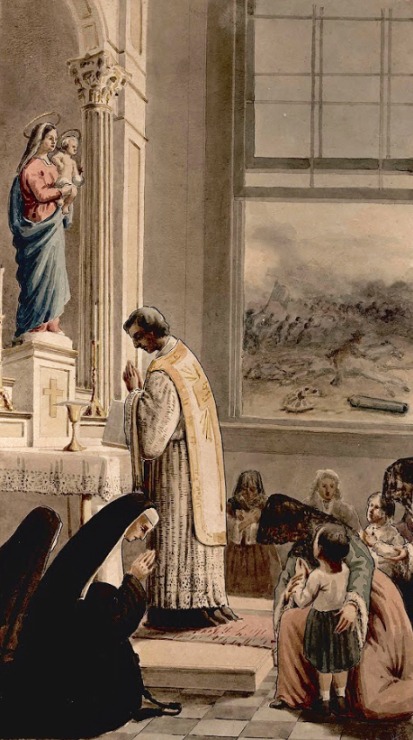 On the morning of January 8, 1815, the Very Rev. Father du Bourg, V.G., afterward Bishop of New Orleans, offered the Holy Sacrifice
of the Mass in the presence of the statue of Our Lady of Prompt Succor; and the community made a vow to have a Mass of thanksgiving sung every
year should the Americans gain the victory. Just at Holy Communion a courier entered the chapel to announce the glad tidings of the enemy's defeat.
After the Mass was finished, Fr. du Bourg intoned the Te Deum, which was sung with a fervor of gratitude impossible to describe.
On the morning of January 8, 1815, the Very Rev. Father du Bourg, V.G., afterward Bishop of New Orleans, offered the Holy Sacrifice
of the Mass in the presence of the statue of Our Lady of Prompt Succor; and the community made a vow to have a Mass of thanksgiving sung every
year should the Americans gain the victory. Just at Holy Communion a courier entered the chapel to announce the glad tidings of the enemy's defeat.
After the Mass was finished, Fr. du Bourg intoned the Te Deum, which was sung with a fervor of gratitude impossible to describe.
Nobody could reasonably doubt of Heaven's intervention on this occasion through the intercession of Our Lady of Prompt Succor.
Jackson himself, the hero of the day, did not hesitate to admit of the divine interposition in his favor; and in his first proclamation to the army,
he says: By the blessing of Heaven, directing the valor of the troops under my command, one of the most brilliant victories in the annals of war
was obtained.
The following day, in a letter to the Very Rev. Fr. du Bourg, the valiant General wrote: Rev. Sir – The signal interposition
of Heaven in giving success to our arms requires some external manifestation of the feelings of our most lively gratitude. Permit me, therefore,
to entreat that you will cause the service of public thanksgiving to be performed in the Cathedral, in token of the great assistance we have received
from the Ruler of all events, and of our humble sense of it.
On the 23rd of January, Father du Bourg proclaimed the same truth when, ere placing the victor's crown on the brow of Jackson,
he thus addressed him: How easy it would have been for you, General, to forget the Prime Mover of your wonderful success, and to assume praise
which must redound to that exalted Source whence every merit is derived! The first impulse of your religious heart was to acknowledge the signal
interposition of Providence.
The same day General Jackson visited the Ursulines, in order to thank them for the prayers which had helped him
to gain so signal a victory.
Have we not here more than sufficient proof of the divine interposition in behalf of the American troops during the famous Battle of 1815? The wonderful success of their arms was then attributed to the intercession of the Blessed Virgin, invoked in the Ursuline chapel under the title of Our Lady of Prompt Succor.
In 1850 the superioress of the Convent sent, though the agency of the Most Rev. Archbishop Blanc, a petition to the Pope, laying before him the signal favors with which the community had, since 1810, been loaded through the mediation of Our Lady of Prompt Succor, and beseeching His Holiness to authorize the annual celebration of the Feast and the singing of High Mass in Her honor on the 8th of January. On the 27th of September, 1851, this favor was graciously granted by Pope Pius IX; and on the 6th of August, 1852, Archbishop Blanc promulgated the papal decree in favor of the Ursulines of his diocese.
May this devotion be propagated throughout the whole world! What a beautiful title for Mary! Our Lady of Prompt Succor implies the urgent need we have of Mary's help; it proclaims that we expect everything from Her; and that, being a good and powerful Mother, She cannot keep Her children waiting for what they need.
The crowning of Our Lady of Prompt Succor in the Ursuline Convent, New Orleans, November 10, 1895, was a remarkable event in the history of that city. The fame of the Shrine, its connection with the happy issue of the War of 1812, the ceremonial pageantry, and the fact that Our Lady of Prompt Succor is the Patroness of Louisiana – all these circumstances combined to make the occasion noteworthy. The ceremony was performed by the Most Rev. Archbishop Janssens, of New Orleans, in presence of a large assemblage of the clergy and laity. In every church of the Archdiocese a solemn novena had been made in preparation for the ceremony, and when the hour for it arrived every church bell in the great Archdiocese of New Orleans rang out in jubilee. The Statue of Our Lady of Prompt Succor was the first in the United States to receive this solemn canonical coronation.
On January 6, 1924, New Orleans Archbishop John Shaw officially dedicated the National Votive Shrine of Our Lady of Prompt Succor. The Vatican gave official recognition of the Patronage of Our Lady of Prompt Succor over the State of Louisiana and the Archdiocese of New Orleans on June 13, 1928. In other places where the Feast of Our Lady of Prompt Succor is observed, the date is January 15 – the octave day of the original Feast – out of respect for the Octave of Epiphany.
Alphabetical Index; Calendar List of Saints
Contact us: smr@salvemariaregina.info
Visit also: www.marienfried.com